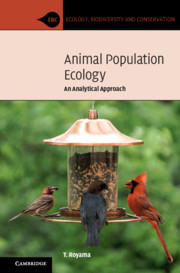Book contents
- Animal Population Ecology
- Ecology, Biodiversity and Conservation
- Animal Population Ecology
- Copyright page
- Dedication
- Contents
- Prologue
- 1 Hunting Strategies of Predators as Revealed in Field Studies of Great Tits
- 2 The Paradox of Crypsis: Is it Effective against Visual Predation?
- 3 Logistic Law of Population Growth: What Is It Really?
- 4 Reproduction Curves and Their Utilities
- 5 Generalization of the Logistic Model
- 6 Scramble and Contest Competition: What Is the Difference?
- 7 Regulation of Populations: Its Myths and Real Nature
- 8 Predator–Prey Interaction Processes
- 9 Interspecific Competition Processes
- 10 Observations, Analyses, and Interpretations: A Personal View through the Spruce Budworm Studies
- References
- Index
3 - Logistic Law of Population Growth: What Is It Really?
Published online by Cambridge University Press: 01 April 2021
- Animal Population Ecology
- Ecology, Biodiversity and Conservation
- Animal Population Ecology
- Copyright page
- Dedication
- Contents
- Prologue
- 1 Hunting Strategies of Predators as Revealed in Field Studies of Great Tits
- 2 The Paradox of Crypsis: Is it Effective against Visual Predation?
- 3 Logistic Law of Population Growth: What Is It Really?
- 4 Reproduction Curves and Their Utilities
- 5 Generalization of the Logistic Model
- 6 Scramble and Contest Competition: What Is the Difference?
- 7 Regulation of Populations: Its Myths and Real Nature
- 8 Predator–Prey Interaction Processes
- 9 Interspecific Competition Processes
- 10 Observations, Analyses, and Interpretations: A Personal View through the Spruce Budworm Studies
- References
- Index
Summary
This well-known law of ecology serves as the basis and the starting line for studying and understanding animal population processes at higher levels of complexity. However, the classical logistic curve, as originally conceived by Verhulst and later by Pearl and Reed, was an empirical law without theoretical bases, and the conventional interpretations of the model’s attributes, i.e. the iconic sigmoid curve and the ‘carrying capacity of the environment’, are misleading. Here I develop a theoretical model on the basis of ecological first principles to critically examine and reinterpret the classical law.
Mathematics (elementary algebra, calculus, or statistics) is an essential part of this chapter. However, I show in an easy-to-follow manner how to construct the original logistic differential equation and how to solve it so that even those students without an adequate background in mathematics would understand the ecological meaning of the logistic law.
Keywords
- Type
- Chapter
- Information
- Animal Population EcologyAn Analytical Approach, pp. 31 - 57Publisher: Cambridge University PressPrint publication year: 2021

